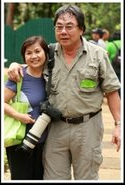I’m trying to remember whatever I could of my grandmother, but I do not have much to go by.
My father’s mother’s name was Liberata Santos. Although she lived to be 85, and I was already in college when she died, I had very scant memories of her, of which very little was based on my own personal experience with her. Most of the stories that I heard about my grandmother were from my aunt and my cousins, with whom she lived, in the big house next to ours.
I do remember that before I started going to grade school, I would go with her to help her peddle fresh fish that she carried on a bilao on her head. Usually, we would not go far, as she had her “suki” (regular patrons) in Don Galo, especially the Pulo area, who regularly bought from her, fish and sometimes some tomatoes, kangkong and labanos for making sinigang. I would be her only grandchild who was available to accompany her as all my cousins were going to school, while my sister and another brother were too young. My older brother was not someone she counted on, and in those days, probably not someone expected to help.
I do remember her long white hair that she regularly treated with coconut oil. She would get the coconut milk (derived by squeezing grated coconut meat) from the maid or her loyal houseboy, Polonio, but would cook it herself to extract the oil. The coconut while being cooked this way was very aromatic, but what we would wait for was the brown “latik” that was formed when coconut milk was cooked. That was delicious. She would transfer the coconut oil to a small bottle and wait for it to cool, and then apply it to her hair. Her straight white hair reached almost her knees, but since she was shorter than 4’10”, that wasn’t too long. She was a bit plump and very fair. Although she spoke a little Spanish (just the prayers and the cusswords), it was obvious from her facial features that she was not Spanish.
For reasons I never got to find out, we addressed and referred to her, not as “Lola” which is the common way, but as “Grandmother” (pronounced the Filipino way – granmader). Her younger relatives called her "Lola" or "Nanang Berata."
I do remember that she was diabetic, and she used to “steal” spoonfuls of sugar from the sugar container, which was kept in my aunt’s trusty GE refrigerator. When caught in the act, she would fight off my cousins who would try to take away the sugar from her. In the physical struggle over a spoonful of sugar, she would always lose, as my cousins were taller and stronger, but that would not stop her from cursing them and her illness, in a flurry of Tagalog and Spanish expletives. Soon, she developed a gangrenous toe that would not heal, and when that was amputated, she finally acquiesced to not having sugar.
When she was too old and sick to sell fish, she kept herself busy by sweeping their front yard with a walis tingting, and sometimes, squatting alongside the asphalted main street (there were no concrete sidewalks then) to arrange the pebbles and stones on the ground. She did not find television (then in its early days – black and white, no remote control, and only two or three channels) entertaining, but would try reading newspapers in English, by syllabicating the words, as English was not a language she knew.
I remember the stories about her because my cousins often teased her about them. She was 16 when she first got married, and had a daughter, my aunt, Kakang Salud (Salud Gutierrez), before she was widowed at age 20. At 24, she married a widower, my grandfather Alejandro Valentino, who had one daughter, Kakang Floring (Florencia Valentino). Lolo Andoy was a cochero. Their union produced my father, Ruperto (“Peting”), but it was, again, a short-lived marriage. At 28 she was widowed for the second time and never remarried. She continued to take care of the three children, two of her own, and her stepdaughter from her second husband.
Although I never saw her wear them, I did get some occasions of seeing her bring out her baro’t saya with matching panuelo. She must have valued those clothes, or why would she keep them when she had no more use for them?
At six o’clock every evening, she prayed the rosary, in Tagalog, and some prayers in Spanish, before an image of Our Lady of the Immaculate Conception, which she kept in an altar in her room. After my grandmother died, this antique image of the Virgin Mary, about sixteen inches in height and encased in glass because she was dressed in a beautifully beaded white and blue dress and made valuable by her ivory hands and face, was transferred to the main altar of my aunt’s house. It was treasured as a family relic from my grandmother.
My “granmader” died in her sleep, in 1966 at the age of 85. I was 20 years old then.
I never thought of keeping a picture of my grandmother, but last week when I visited my cousins, I asked if they were able to save any pictures of her. Unfortunately, a fire gutted my cousins’ house and my parents’ house a few years ago, and nothing was saved – not any photos, not her “baro’t saya” and “panuelos,” and not the image of the Blessed Virgin Mary of the Immaculate Conception, which was her most prized possession.
Deprived of any physical reminders, I would just have to keep an image of her in my mind, and hope that this story would help introduce my grandmother to my children, especially when I get too old to remember correctly.
Subscribe to:
Post Comments (Atom)

No comments:
Post a Comment